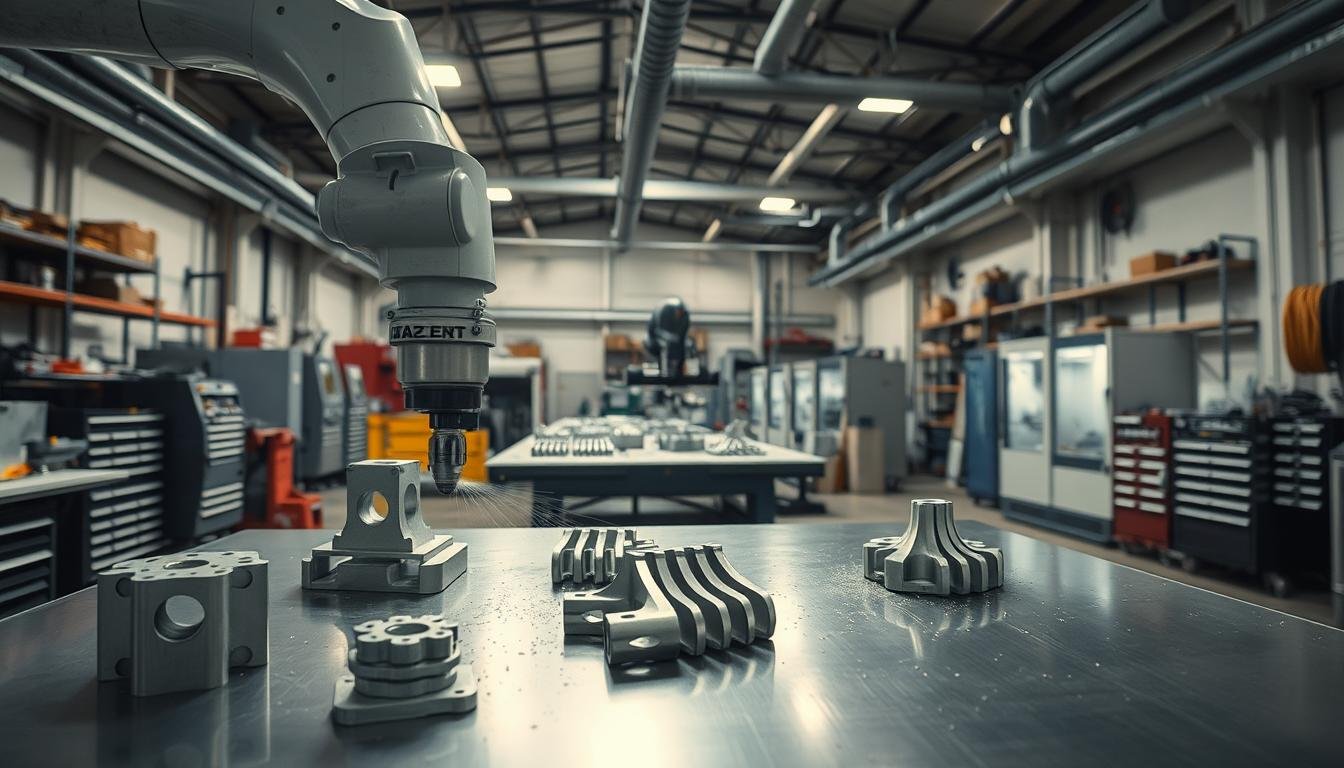In CNC machining aluminum parts, following best practices is key. This method is great for precision and tight tolerances. It’s perfect for many metal fabrication needs.
We focus on making your designs into perfect parts. We stress the need for sheet metal finishing services. This helps make your products better and meet high standards.
Key Takeaways
- Understanding best practices is essential for CNC machining aluminum parts.
- Precision and tight tolerance levels significantly improve manufacturing outcomes.
- Integrating advanced technologies can enhance production efficiency.
- Quality control measures ensure high standards in metal fabrication.
- Utilizing proper finishing techniques can add value to aluminum components.
Understanding CNC Machining for Aluminum
CNC machining is a big step forward in making things, mainly with aluminum. It uses CNC tech to cut, shape, and form materials. This makes making aluminum parts more efficient and precise.
Aluminum is great because it’s easy to work with and doesn’t rust easily. It’s also light, which is good for many uses. CNC machining helps make parts that fit exact standards.
Using CNC tech lets us make complex shapes easily and consistently. Knowing how CNC works helps us design better and make more. This way, we can make lots of high-quality parts.
Adding CNC machining to our work makes our products better. It also helps us keep up with what our customers need.
Benefits of CNC Machining Aluminum Parts
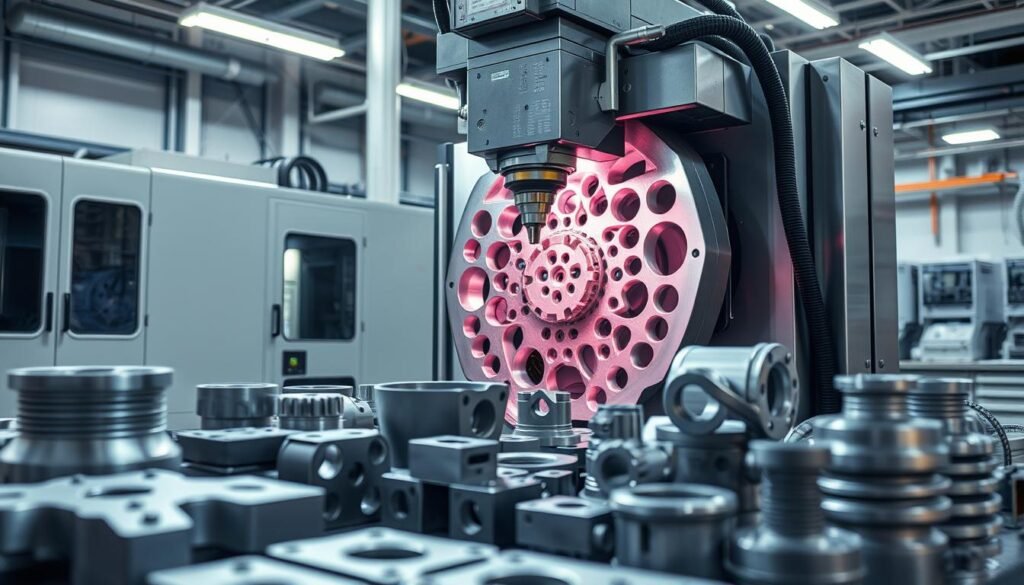
CNC machining aluminum parts has many advantages. Aluminum is light, which means lower shipping costs. This is a big win for businesses looking to save money.
Aluminum also doesn’t rust easily. This makes it last longer in tough places. It’s a durable choice for many products.
Aluminum is strong for its weight. This lets makers create detailed designs without losing strength. CNC machining ensures parts are made just right, meeting all the needed standards.
CNC machining works well for making lots of parts or just a few. It’s flexible and helps companies adjust to changing needs. Using CNC machining can make a business more profitable.
Design Considerations for Optimal Machinability
To make high-quality aluminum parts, design-for-manufacturing is key. This means using strategies that help with machining. Important things to think about include:
- Choosing the right cutting tools: Tools made of carbide with the right angles make cutting better and reduce damage.
- Optimizing cutting parameters: Changing the speed and feed rates lowers heat, which helps tools last longer and improves quality.
- Using good clamping methods: Methods like threaded mandrels or fillings make the workpiece stiffer, reducing damage and improving accuracy.
Aluminum sheet metal is usually between 0.024 in. and 0.250 in. thick. This affects how designs are laid out. Hole sizes must match the material’s thickness for strength. Bends need careful planning, with features at least four times the material’s thickness away to avoid damage.
It’s important to keep the temperature right during machining to stop the material from getting soft. Good cooling and chip removal are key. Tools with fewer flutes and air blasting to clear chips help keep the surface smooth.
For more details, check out CNC machining design guidelines. They offer deep insights into making machining better and boosting production.
Sheet Metal Finishing Services
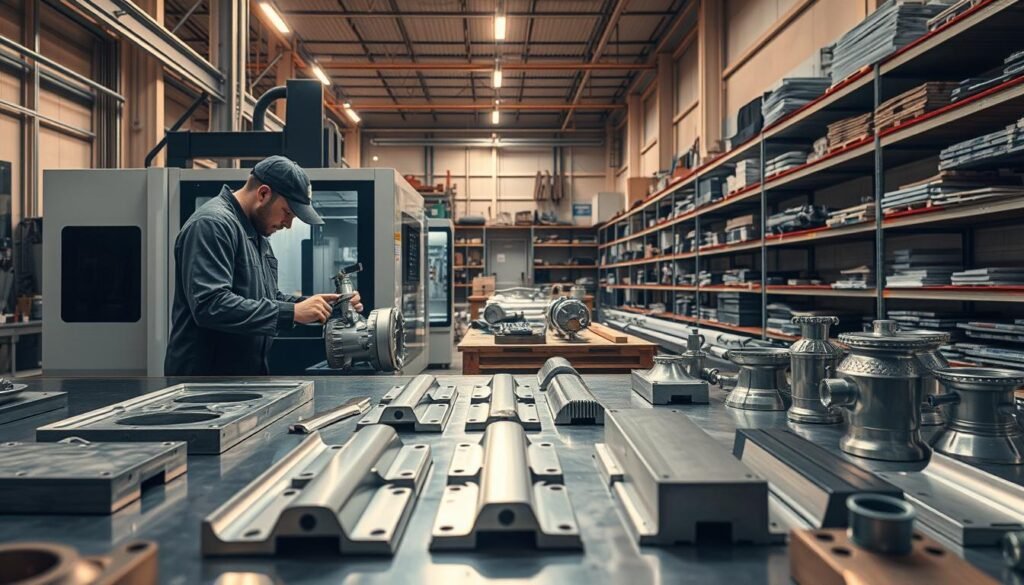
Sheet metal finishing services are key to making aluminum parts last longer and look better. Our custom metal finishing meets your needs and follows industry rules.
There are many finishing processes to get the best results. Anodizing adds a protective layer against rust, which is vital in harsh conditions. Polishing makes the surface shiny, making products more attractive.
We use the latest surface treatment methods to meet high standards. This makes the parts more durable against wear and chemicals, making them last longer.
Choosing top-notch metal finishing services means making products that really stand out. We focus on precision to ensure every project is up to par. For more details, check out our services page.
Common CNC Machining Processes for Aluminum Parts
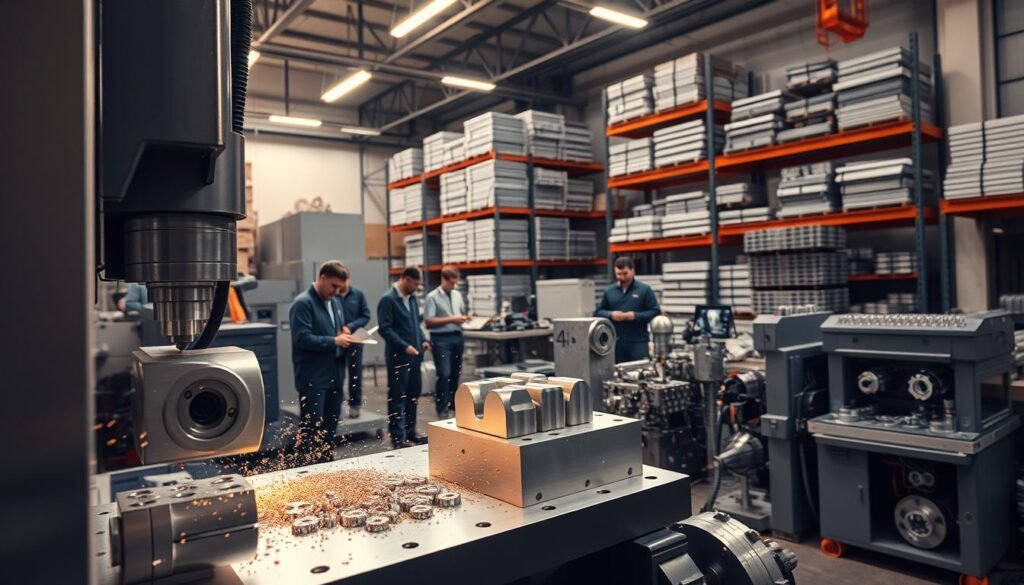
Creating aluminum parts needs several key CNC machining steps. These steps are designed for precision and quality. They help make complex shapes and precise parts for many industries.
CNC Milling Techniques
CNC milling uses cutting tools to shape aluminum into detailed designs. It’s great for parts needing tight tolerances. Milling is versatile, fitting many aluminum projects and boosting design options.
CNC Turning Processes
Turning is key for making round parts. It shapes aluminum by moving it against a tool. This method ensures parts are accurate and consistent.
Advanced CNC programming lets us make complex shapes and threads. Our skill in CNC turning improves production quality a lot.
CNC Drilling and Tapping Methods
CNC drilling makes precise holes in aluminum for assembly. Tapping adds internal threads. These steps are crucial for parts to fit right.
Our use of the latest tech in aluminum work makes production efficient and reliable.
Cutting Parameters and Tool Selection
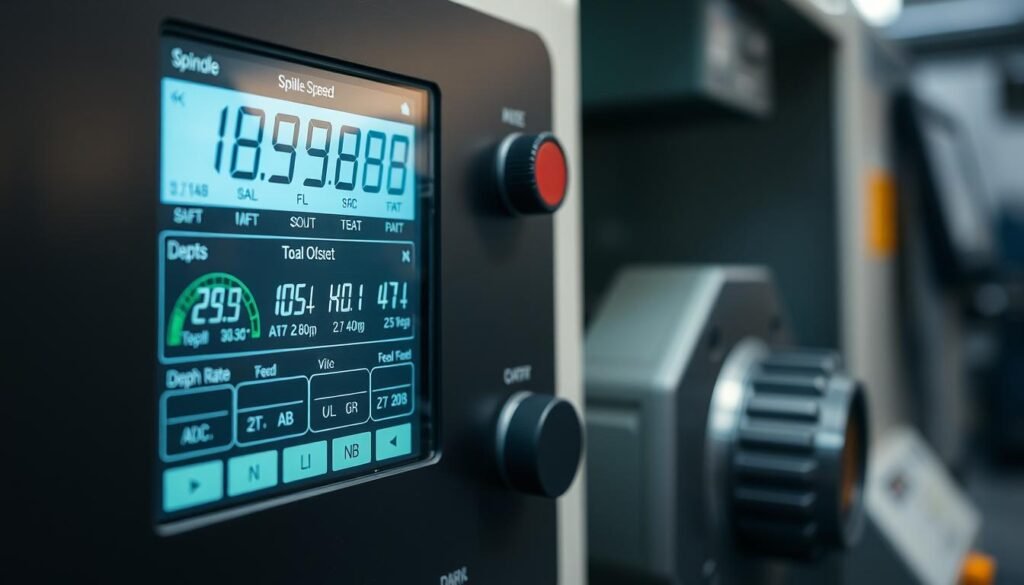
Choosing the right cutting parameters and tools is key for great CNC machining results. Factors like cutting speed, feed rates, and tool material are very important. Knowing these can make your machining better and last longer.
When setting up machining, it’s important to think about aluminum’s properties. The right cutting settings help make chips well and reduce tool wear. This is crucial for making high-quality, detailed aluminum parts.
Here are some tips for picking tools:
- Cutting Speed: Pick a speed that fits the material and finish you want.
- Feed Rate: Change feed rates based on part complexity and tool ability.
- Tool Material: Use high-speed steel or carbide for lasting, effective cutting.
Using these tips will make machining more efficient. This means more work done and better results in aluminum making.
| Parameter | Recommended Range for Aluminum |
|---|---|
| Cutting Speed (Surface Feet per Minute) | 600 – 1200 |
| Feed Rate (Inches per Minute) | 10 – 50 |
| Tool Material | Carbide or HSS |
Cooling and Lubrication Techniques
In CNC machining of aluminum, it’s key to use good cooling and lubrication. This helps tools work well and keeps workpieces safe. We’ll look at how to pick the best coolant and lubrication for aluminum, keeping temperatures right and surfaces smooth.
Effective Coolant Selection
Picking the right coolant is crucial for aluminum machining. It stops thermal deformation and corrosion. Coolant choice depends on:
- Type of coolant: Water-based coolants cool and lubricate. Oil-based coolants are better for aluminum’s sticky nature.
- Concentration: The right coolant amount is important. It stops bacterial growth and tool wear. Use hand refractometers to check levels.
- Cooling performance: Good coolants reduce heat during machining. This helps remove chips and extend tool life.
For finishing, use low-viscosity cutting oils and emulsified anti-friction cutting fluids. Stress on cooling performance means coolants must resist rust well and be easy to maintain. This is key to stop corrosion in aluminum.
Lubrication Strategies for Aluminum Machining
Good lubrication is key in CNC machining. It boosts productivity and stops material sticking. Different strategies include:
- Flooding: Gives lots of lubrication and cooling but needs a lot of coolant.
- Minimum Quantity Lubrication (MQL): Uses a little lubricant on the tool. It saves fluid but works well.
- Misting: Turns coolant into fine particles. It saves fluid and covers well.
In our workshops, we focus on effective lubrication for smooth machining. This prevents errors from heat and keeps machines running. Knowing how cooling and lubrication work together improves tool performance and product quality.
Importance of Fixturing and Workholding
Fixturing methods and workholding techniques are key to making aluminum parts. They help in getting CNC machining right. Keeping the work stable is very important for quality parts.
Strong fixtures and clamps help avoid shaking and bending during machining. This makes cuts more precise and parts smoother. We follow the best practices in fixturing to meet high standards.
Using advanced fixturing can make processes faster and more efficient. Choosing the right workholding techniques helps avoid problems like parts not fitting right. Good workholding setups are crucial for top CNC machining results.
Surface Finishing Techniques for Aluminum Parts
In CNC machining, surface finishing is key for both looks and function of aluminum parts. The right finish can make them last longer, look better, and be easier to keep up. Anodizing, polishing, and protective coatings are top choices.
Anodizing Overview
Anodizing is an electrochemical treatment that makes aluminum’s oxide layer thicker. This creates a strong, corrosion-resistant finish that can be colored for looks. It’s great for sticking things to aluminum because it doesn’t chip or peel.
Keeping anodized aluminum clean is easy. Just use mild soap and water. It’s perfect for many fields like cars and planes.
Polishing Methods
Polishing aluminum makes it shine with methods like buffing and grinding. It removes blemishes for a glossy look. Polished aluminum is popular in gadgets and car parts.
While it looks great and protects a bit, it needs regular care. This keeps it shiny and fights off rust.
Coating Options for Enhanced Durability
Coatings like powder coating and paint add extra protection. Powder coating forms a hard layer when heated. It’s great against scratches and fading.
Paint offers color choices and some protection against rust. But it’s not as tough as powder coating. Both help aluminum parts look better and last longer in many fields.
Conclusion
In this CNC machining summary, we’ve looked at how CNC technology helps make aluminum parts. We talked about the importance of cutting parameters and tool selection. We also covered cooling and lubrication techniques.
Our best practices recap shows why paying attention to detail is key. This includes design, fixturing, and finishing. Following these steps helps make machining better and improves aluminum parts’ durability and performance.
As we wrap up, we urge manufacturers to use these insights to excel in CNC machining. By following these best practices, we can keep making high-quality aluminum parts. This way, we ensure customer happiness is always our top priority.
FAQ
What are the best practices for CNC machining aluminum parts?
Best practices include following design-for-manufacturing (DFM) principles. Also, choose the right cutting parameters. Use effective cooling and lubrication techniques. These steps improve precision, efficiency, and surface quality.
Why is aluminum a preferred material for CNC machining?
Aluminum is preferred for its excellent machinability and lightweight nature. It also has high corrosion resistance and a strong strength-to-weight ratio. These qualities make it great for detailed designs and durability.
What advantages does CNC machining offer for aluminum parts manufacturing?
CNC machining offers high dimensional accuracy and supports both large and small production. It also reduces shipping costs because aluminum is light. Plus, it’s cost-effective and can make complex shapes.
How can design considerations enhance the machinability of aluminum?
Designing features to align with main machining directions helps. Using proper corner radii and minimizing cavity depths improves tool access and reduces wear. This also enhances surface quality.
What are some common sheet metal finishing services for aluminum?
Common services include anodizing, polishing, and coating. These processes improve both looks and function of aluminum parts. They also increase durability and surface quality.
What CNC machining processes are typically used for aluminum fabrication?
Common processes include CNC milling for complex shapes, CNC turning for cylindrical parts, and CNC drilling and tapping for precise holes. These are needed for assembly.
How do cutting parameters influence CNC machining results?
Factors like cutting speed, feed rates, and tool material are key. Optimizing these based on aluminum’s properties ensures efficient machining. It also extends tool life, balancing speed and quality.
What cooling and lubrication techniques are essential for CNC machining aluminum?
Choosing the right coolant is crucial to manage heat during machining. Use water-soluble coolants and lubrication strategies made for aluminum. This improves tool performance and extends tool life.
Why is effective fixturing important in CNC machining?
Effective fixturing is key to prevent deformation and ensure accurate cuts. Robust fixtures and clamps improve machining accuracy and surface quality.
What are the surface finishing techniques used for aluminum parts?
Techniques include anodizing for corrosion resistance and looks, polishing for smooth finishes, and various coatings like powder coating. These add protection and enhance appearance.


